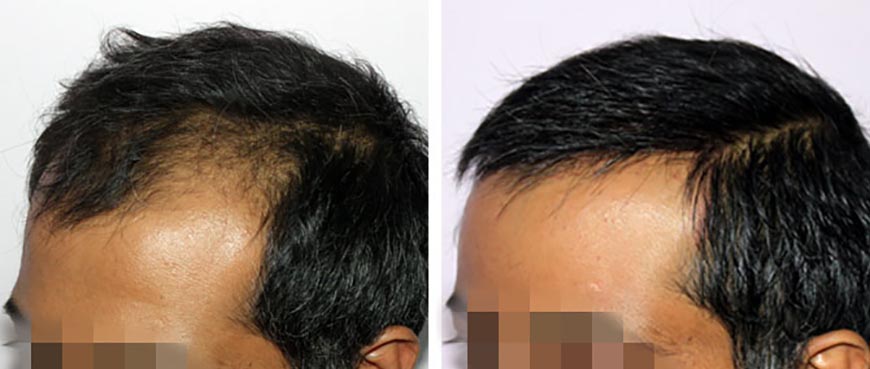A Newer Medical Treatment for Pattern Hair Loss
Laser light generated by low-powered (cold) lasers has recently come into use as a non-surgical hair restoration treatment for pattern hair loss. Hand-held "comb", "brush" or "cap" laser devices are marketed for use at home. Larger "hood" or "cap" devices are used in hair restoration clinics. Laser light is not approved or recommended for treatment of hair loss due to any other cause. If the cause of hair loss is questionable, you should see a physician hair restoration specialist for appropriate examination and diagnosis before using a LLLT laser(low level laser therapy).
The use of lasers for medical purposes is not new. Lasers have been in use for medical purposes for many years and the physics, chemistry and biology of laser light interaction with human tissue are well documented. Medical uses range from surgery using high-powered lasers to stimulation of tissue repair. Use of laser light as a hair replacement therapy for treatment of hereditary hair loss is a newer application of laser technology.
The "cold" lasers used as a hair replacement therapy for the treatment of androgenetic alopecia deliver what is called low-level laser therapy (LLLT). The LLLT lasers are called "cold" because their light is absorbed by target tissue but does not heat the target tissue as occurs with lasers used to cut and remodel tissue.

The Mechanics of a Laser
The laser is a device for producing and emitting light of a very specific wavelength and power (wattage). The specificity (coherence) of wavelength is what makes lasers unique. The wavelength (color) of laser light and the wattage are selected for the specific purpose to be accomplished. Thus, lasers that emit narrow wavelengths of green, red, infrared, etc., are selected and paired with appropriate wattage for specific purposes. The laser light used for treatment of pattern hair loss is visible red light with wavelength of 630-670 nanometers and low power (wattage).
LLLT in Hair Restoration: How It Works
The interaction between laser light and living tissue is defined as photobiology. Photobiology can be subdivided into laser-tissue reactions defined as photochemistry and photophysics—that is, stimulation of chemical or physical reactions by laser light. The use of light of any wavelength for medical purposes is defined as phototherapy.
Why is visible red light in the narrow spectrum of 630-670 nanometers and low power crucial for treatment of pattern hair loss? The answer is: because red light in that narrow spectrum at low power is absorbed by hair follicle molecules critical to stimulating hair growth or regrowth. Absorption of light by the hair follicle molecules is essential in order for biological reaction to be stimulated in the molecules. If light is not absorbed, no photobiological reaction will occur.
An accidental observation in laboratory mice in 1967 led to discovery that visible red laser light stimulates hair growth. A Hungarian scientist investigating the effect of laser light in treating skin cancer noticed that hair grew back more quickly on the skin of shaved mice treated with visible red laser light.
Research has shown that visible red laser light in the 630-670 nanometer spectrum is absorbed by an intracellular enzyme (cytochrome c). Photobiological reactions stimulated in cytochrome c sends signals throughout cells of the hair follicle, stimulating enhanced gene activity, decreased apoptosis (gene-regulated cell death), and other changes that enhance cell activity and survival.
LLLT does not stimulate hair regrowth in every person. If intracellular molecules are unable to absorb laser light, or unable to adequately respond to absorbed light, no stimulation of hair regrowth will occur.
Experience has shown that stimulation of hair regrowth by LLLT is more likely to occur when hair loss is minimal to moderate, less likely when hair loss is major and/or long standing. Physician hair restoration specialists who use LLLT in a treatment plan for a patient’s pattern hair loss have often noted that LLLT is more effective when used in conjunction with other medical therapies such as minoxidil or finasteride. Some physician hair restoration specialists have reported that LLLT may enhance hair growth and reduce inflammation after hair transplantation.
LLLT is not a "one time only" treatment for pattern hair loss. As with other medical therapies, treatment must be repeated at intervals to maintain hair regrowth results. Hair transplantation is the only permanent treatment for pattern hair loss.
LLLT Devices
Hand-held LLLT devices for home use are marketed to the individual consumer. Larger LLLT devices are used in hair restoration clinics. Hand-held LLLT devices for home use that are currently marketed on the World Wide Web and by advertising in print media .
The potential consumer should compare hand-held devices not only for price, but also for features such as scalp coverage and power.